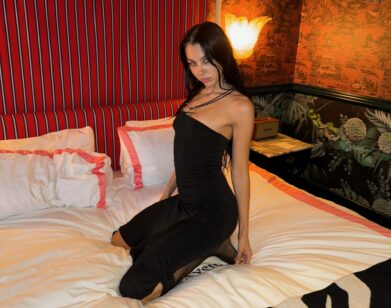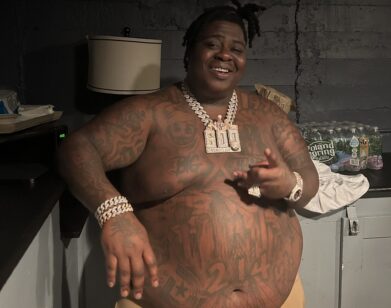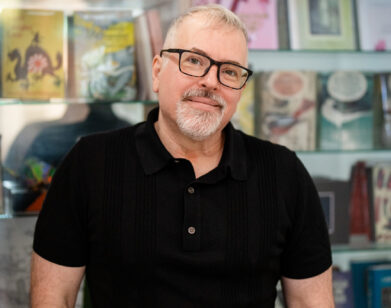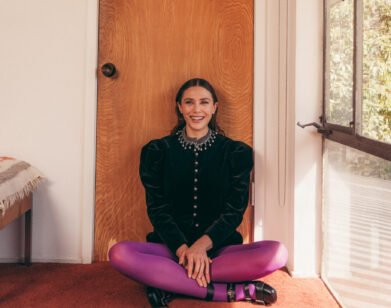Apple of Your Eye
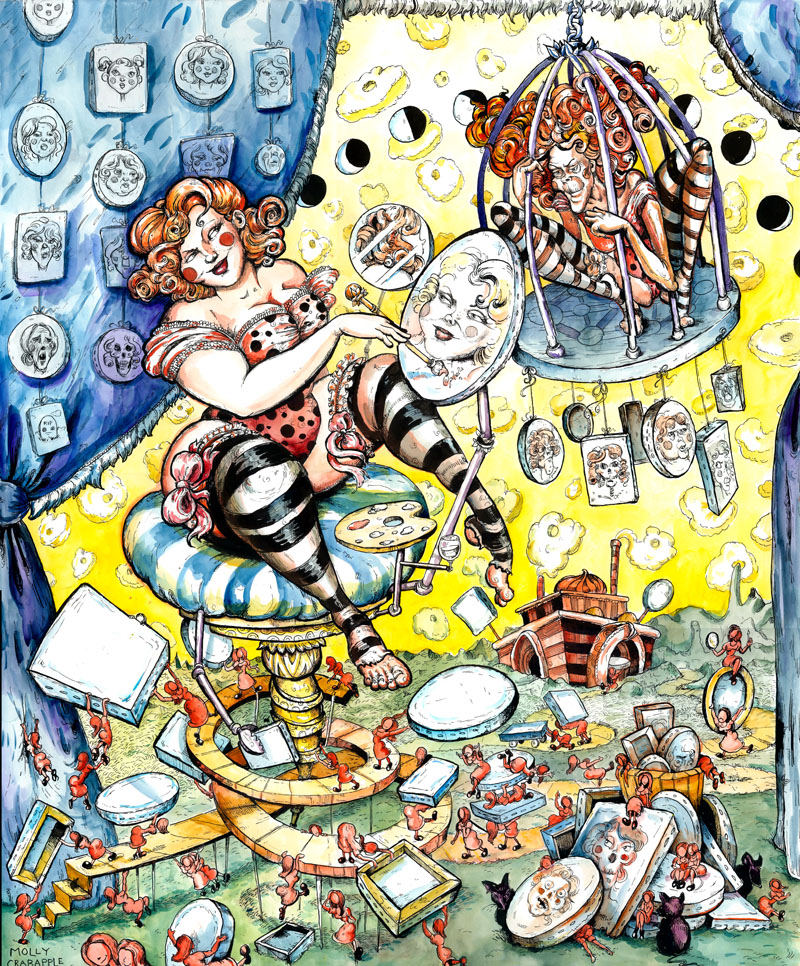
Long Portrait: Molly Crabapple from Clayton Cubitt
Molly Crabapple has graduated from model to artist to muse. After years earning a living as a nude artist’s model for photographers, artists, and life-drawing classes, the now 25-year-old jettisoned the profession’s silent and sexless conventions and founded Dr. Sketchy’s Anti-Art School in 2005 with the aim of “making drawing naked people sexy.”
Combining cabaret and vaudeville with actual sketching sessions, Dr. Sketchy has transformed an activity over-populated with students, frozen life-models and retirees into a sexy subculture. Since Dr. Sketchy’s inception, the artist from Far Rockaway, New York, now named Crabapple has enlisted fetish performers, musicians, and other artists into her roaming troupe of creative collaborators who contribute to officially licensed Dr. Sketchy’s branches in more than eighty cities across Europe, the Americas, and Asia. Models pose in classic vaudeville or circus costumes as beloved characters such as the bearded lady, Siamese twins (two pinup-worthy blonde babes connected by a massive shared stuffed bra) or “Cathy Cow Girl,” Ron English’s signature character of a sexy cow with four nipples on her full human breasts. In the words of the New York Times Crabapple is a “downtown phenomenon.”
An artist and illustrator in her own right, Crabapple’s bawdy, ornate drawings present dramatic visions densely packed with cheeky can-can girls, vixens, villains, alligators, and amorous octopuses. She has exhibited paintings in London and New York, and at Miami Basel, and her illustrations have appeared in editorial pages for The New York Times, Wallstreet Journal, Marvel Comics, Playgirl and SCREW magazine. She has also authored graphic novels, Dr. Sketchy’s pin-up calendars, and kinky coloring books.
After being generously introduced by Clayton Cubitt (who filmed her for the video portrait seen here) on the occasion of Molly’s hosting a Dr. Sketchy’s session in Berlin, we meet up and talk over
salad and lots of coffee:
ANA FINEL HONIGMAN: Do you see a separation between your fine art and illustration?
Molly Crabapple: Not really. Not so much now that people hire me for my
style and they know that my name has a following. But the type of work
I do, which is often called “Pop surrealism,” is very separate from Gagosian and Mary Boone type of gallery art. Even though this year Shepard Fairey, who I have shown with in gallery shows, is probably the most famous artist in the world. Or at least the creator of the most famous image in the world. If you think about, the Sistine Chapel was Michelangelo doing a client assignment for a very powerful man. He was told what to paint. All the old masters did that. Most fine artists were people doing assignments for clients until relatively recently.
AFH: Is there class prejudice in the fact that a more general audience will see a work of illustration, and so its to appeal to mass taste, or do you find the class component relating mostly to the commissioning process?
MC: I think there might be some elitism about who seems the final product. But I think that mostly there is a general dislike for talking about money. Art is for the elite because it has a very high price-point of entry. And when one is in that social strata, they look down at illustrators because they just draw things directly for a few hundred dollars and that’s seen as being a bit grubby. Galleries allow artists to stay relatively divorced from the financial aspects of their trade. I am lucky because I do fine art, and that is half of my living. And then illustration provides the other half.
AFH: How did artist modeling become such a central part of your own creative activity?
MC: Working a model liberated me from ever having to hold a day job. I transitioned from doing that to working full-time as an artist. If you’re 19 and living cheap, being an artist model can sustain you. I dropped out of college at 21 and my illustration hadn’t yet taken off. It is more than working in a store. It is a hard way to make a living but you earn more than in a similarly unskilled job.
Photo by Justin Reed
AFH: I think standing still is an awe-inspiring skill, because I am quite fidgety. What in your experience as a model inspired Dr. Sketchy?
MC: I had lots of time to develop opinions about what a drawing class could be. When you’re modeling, you’re just sitting there staring into space. So it’s very natural to start thinking, “How can this be done better?” I got the idea to take life-drawing classes I’d been posing at, and drawing with, and instead invite my friends from the performance scene to pose. It was packed. Then I wrote a tutorial on how people in other cities could start branches and within a month there was a Dr. Sketchy’s in Melbourne and Virginia.
AFH: What were your strongest complaints about conventional life-drawing?
MC: I felt that the model was being treated as nothing but a collection of tendons. It was objectifying, but not in a sexual way. It was turning the model into a an object, like a table. I didn’t like it. Because so many people have problems with nudity, the convention treats the models as less than people. In most classes, models are not allowed to speak to the class. How better to make it understood that, “You are tendons. You are a table?” I think that is done to lessen people’s discomfort with the fact that they are looking at a naked person. They think it makes the audience and model more comfortable. But that was not the case when I modeled and I find that others agree. I feel that the sexual component is essential. I feel it is much more objectifying to be a table than a beautiful naked girl.
AFH: But you don’t usually do actual nudity at Dr. Sketchy
MC: No. It was too complicated to get the right license in New York to work in a bar. And I liked that the costumes helped me get into character. I think they are like tableaux vivants. And I am very interested in vaudeville as a agent of class transformation, where struggling people could get into the hearts and wallets of their social betters.
AFH: Do you feel that conventional life-drawing classes are lacking as pedagogical tools?
MC: They are good ways to teach anatomy.
AFH: What skills are the people attending Dr. Sketchy’s looking to learn? Are they there to learn anatomy or what else one looks for in a figure drawing class?
MC: When you are an artist, going to a life-drawing class is like going to the gym. It is a very essential act that one needs to do but the results produced there are not necessarily the end goal. The goal is to hone your skills for your paintings. I think people who attend Dr. Sletchys are there to sharpen their skills in an interesting environment. They are not there to do a finished painting. When one runs on a treadmill, they get better but they are not necessarily being taught anything. When you life-draw, you practice seeing things: You practice getting your hand to do what you want it to do. You practice a different style and different ways to make marks. The experience itself teaches you without anyone giving a formal lesson.
AFH: Do people tend to be satisfied enough with the experience to not get frustrated by their potential lack of skill?
MC: I actually presided over a corporate retreat for a massive soft drink company’s executives, through a company that runs retreats. It was really interesting because we were in South America and my friend, an instructor at the Art Students League, taught them how to draw. It was fascinating because none of them had ever drawn in their lives.
AFH: Weren’t they just happy with the pretty ladies?
MC: I think at first, they thought it was cool that a pretty girl came out. But they were surprised that the drawing itself was actually difficult. They were getting really frustrated. I don’t play any musical instruments. But if I had a class where I was given a guitar, I wouldn’t expect to instantly be able to do it. But I guess these guys were such Masters of the Universe that they expected to be able to draw immediately.
AFH: I think people always assume that they can draw or write, possibly because they did as children.
MC: That might be it, whereas they know that they can’t professionally dance or play the tuba. But they can still enjoy trying.


